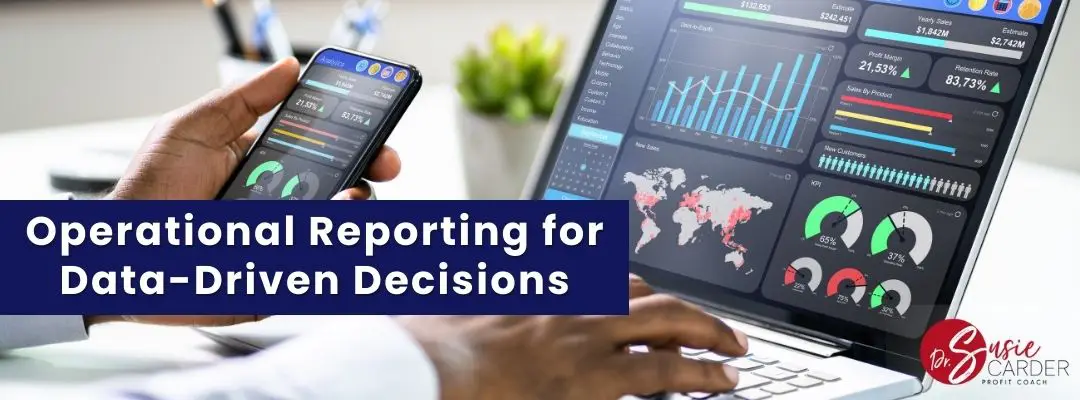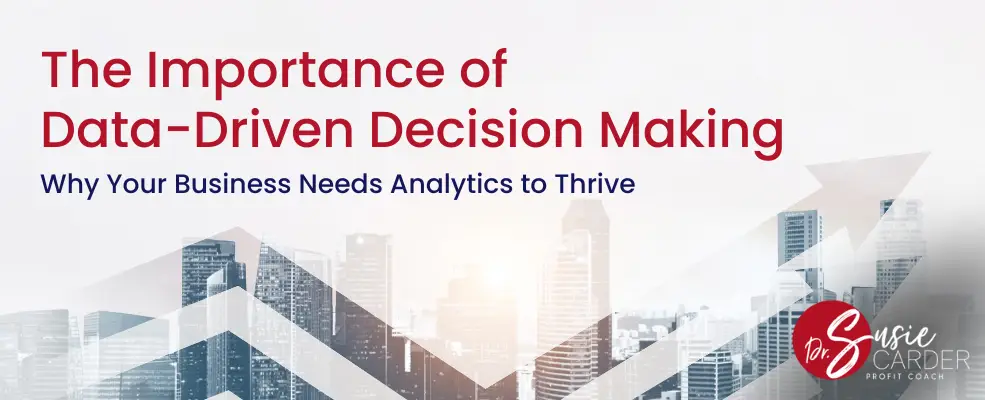The gap between being good and being great all boils down to how you collect, analyze, and, most crucially, act on data. Learning how to use operational reporting for data-driven decisions is very helpful. It can give you a competitive edge in any industry.
What I love about using data is that data doesn’t lie. I know so many times we as entrepreneurs use our feelings to manage our businesses. I am continually surprised by how many people say well it just feels right. Well I am sorry to say but feelings have nothing to do with business we have to look at the facts.
Understanding Operational Reporting
Operational reporting plays a crucial role in the daily activities of a business. For best results, track progress, analyze results, and provide accurate information on a variety of measures and performance indicators. This helps businesses understand how they’re doing in various areas.
This valuable data is gathered and compiled into reports. Business leaders use these reports to get a clear picture of their company’s performance.
This information helps them make decisions and plan strategies to keep the business on track and reach its goals. Armed with this knowledge, they can make informed decisions and plan strategies to achieve the business’s goals.
Essential Components of Operational Reports
Operational reporting is far from one-size-fits-all. The types of operational reports can vary widely, but they generally share common features, including:
- Key performance indicators (KPIs): Measurable values that demonstrate how effectively a company is achieving key business objectives.
- Data sources: The various origins of data that are utilized to generate real-time reports and analytics.
- Narrative: A detailed account that interprets the implications of the data for the functioning of the operation.
Real-world Scenarios of Operational Reporting
Various industries observe practices and concepts of operational reporting. Manufacturing firms use reports to track production, while service organizations focus on customer satisfaction.Taking the following companies as examples, it becomes clear how crucial operational reporting is for enhancing your business’s effectiveness.

Amazon
Amazon heavily depends on operational reporting to oversee different facets of its e-commerce activities, such as sales efficiency, inventory control, fulfillment of orders, and customer support. Using real-time reports, Amazon tracks key metrics such as order processing times, product availability, warehouse efficiency, and customer satisfaction ratings. This allows Amazon to refine its supply chain operations and ensure a smooth shopping experience for its customers.

Tesla
Tesla employs operational reporting to oversee its manufacturing processes, supply chain, and service networks. The company depends on these reports for monitoring production efficiency, quality control indicators, inventory amounts, and customer service effectiveness. Through operational reporting, Tesla is able to pinpoint production constraints, improve its supply chain management, and boost the customer experience overall.

Delta Air Lines
Delta Air Lines uses operational reporting to enhance its flight operations, passenger services, and maintenance efforts. It depends on these reports to monitor vital statistics, including punctuality, flight delays, aircraft usage, and customer satisfaction levels. Through real-time analysis of operational data, Delta is able to proactively oversee its services, reduce interruptions, and provide an exceptional travel experience to its clients.
Benefits of Operational Reporting
There are many benefits to having a strong system for reporting how things operate. When companies use this tool to analyze data, they can boost their performance and have a clearer strategy.
- Real-time Visibility and Transparency
Operational reporting provides a real-time view of performance, allowing you to identify issues as they arise and make immediate adjustments. It also fosters transparency within the organization, ensuring all stakeholders have access to the same information. - Enhanced Decision Making Via Data Insights
With access to accurate, timely data, decision-makers can be confident that their choices are well-informed. Operational reports allow for confident, objective decision-making that aligns closely with business objectives and operational realities. - Increased Efficiency and Productivity
By automating the gathering and reporting of operational data, you can free up valuable human resources for more strategic tasks. This improvement in efficiency ripples through the organization, positively impacting productivity at every level.

Implementing Operational Reporting
A clear, strategic approach to implementing operational reporting sets the stage for data-driven success.
- Figure out the main goals of the operational reporting system.
Different groups like managers, department leaders, and teams have specific needs for the reports. Set up the rules for the reporting system. Decide what information will be included, how often reports will be made, and who should get them. - Identify your Key Performance Indicators.
To find the right KPIs, figure out the most important measurements of how well things are going. Work together with the people involved to make sure these KPIs fit with what the organization wants to achieve. Then, put these KPIs in order based on how important and relevant they are for making decisions and checking on performance. - Collect data.
Find out what sources of data you’ll use for reports. This includes transaction systems, databases, spreadsheets, and information from outside. Check how good, accurate, and reliable the data from these sources is.
If there are any problems with the data quality, figure out how to fix them. Decide how often and how you’ll gather data to make sure the reports are up-to-date and accurate.
Make templates and dashboards for reporting that show important data and how well things are going clearly. Think about what different people in the company need and like when you make these reports.
Use easy-to-understand pictures and make parts interactive. It’s also a good idea to use the same style for all reports in the company. This makes it easier for everyone to understand and compare how well different areas are doing. - Establish data governance policies. Set up rules and processes to keep the information used in reports accurate, safe, and confidential.
Create clear roles and responsibilities for looking after the data, getting to it, keeping its quality high, and following the rules. To maintain trust in your reporting framework, put checks and balances to ensure data governance policies are being followed. - Testing and revisions.
Test to ensure the reporting achieves its intended purpose and meets your needs. Talk to the people involved and those using it to learn what could be better. Keep improving by using what you learn from feedback to make the reporting more useful and relevant.
Best Practices for Effective Operational Reporting
With the right foundation and framework laid, it’s time to focus on best practices to ensure your operational reporting strategy remains effective.
Standardizing Reporting Processes
Consistency is key to the successful deployment of operational reporting. By implementing standardized processes, you ensure that reports are easily interpreted and compared over time.
Ensuring Accessibility and Usability
Reports should be readily available to those who need them and in a format that they understand. This section will cover strategies for ensuring broad accessibility and high usability.
Training and Educating Report Users
A report is only useful if its readers understand it. We will discuss how to foster data literacy within your organization, enhancing the effectiveness of your reporting strategy.
Monitoring and Optimizing Reporting Systems
Your reporting system should be a living, evolving entity, capable of capturing the changing nature of operations. Regular monitoring and adjustment ensure that it remains a valuable tool for decision-makers.

Case Study – American Express Global Business Travel
Real examples show how useful operational reporting can be. Read on to find out how American Express Global Business Travel used these reports to make better decisions and grow their business.
American Express Global Business Travel faced several challenges in managing travel expenses and optimizing travel bookings for their clients, which operational reporting helped to solve.
The Challenges
Before using reports, American Express GBT had trouble with slow and mistake-prone travel booking. It was hard to make bookings better or offer tailored advice to customers without knowing the trends and what customers liked.
The lack of immediate, accurate data on travel costs and booking habits made it difficult for the company to provide cost-saving advice or negotiate better deals with travel providers.
Identifying client cost-saving opportunities was challenging for American Express GBT, as they lacked detailed information on travel expenses, booking patterns, and supplier efficiency. This complexity hindered consolidating bookings, securing discounts, and enhancing travel budget management.
Another challenge faced by American Express GBT was ensuring the quality and accuracy of data for operational reporting. Discrepancies, inconsistencies, and errors in data sources impeded the company’s capability to derive reliable insights and make decisions informed by operational reports.
The Solution
American Express Global Business Travel GBT tackled its challenges by using operational reporting to obtain instant insights into travel expenses and booking trends. This approach helped them refine their travel booking procedures and discover ways to save costs for their clients.
Specifically, the solution included:
- Implementation of Operational Reporting Systems pulled data from various sources, including travel bookings, expense tools, and vendor invoices. These systems provided immediate insights into travel expenses, booking patterns, and supplier performance. This enabled data-driven decisions, enhancing operational efficiency.
- Data Integration and Standardization addressed compatibility issues, data formats, and ensured data quality and accuracy. By merging data from multiple sources, American Express GBT gained a detailed view of travel expenses and booking trends, enhancing report and analysis precision.
- Customized Reporting Dashboards provided stakeholders with instant insights and actionable advice. Through these dashboards, clients could track travel expenses, comply with travel policies, and identify cost-saving opportunities. By tailoring these dashboards to each client’s needs, American Express GBT boosted its service value and strengthened client relationships.
- Travel Management Strategies were created with insights from operational reporting to improve the client’s travel experience. This included updating travel policies, securing better rates from vendors, and providing customized itinerary planning advice.
The Result
American Express GBT addressed its challenges by implementing operational reporting solutions, offering instant insights into travel costs and booking patterns.
This allowed for the:
- Optimization of booking procedures.
- Uncovering opportunities for cost savings.
- Guaranteed the data’s accuracy and dependability for decision-making.
In summary, operational reporting was key in enhancing American Express GBT’s travel management strategies, managing expenses more effectively, and offering increased value to its customers.
Future Trends in Operational Reporting
Preparation for the future is as crucial as analyzing the present. Anticipate upcoming trends in operational reporting that could further enhance your decision-making capabilities.
The Intersection of Operational Reporting and New Technologies
Emerging technologies are on the verge of reshaping operational reporting. We’ll examine how tools such as AI and machine learning are likely to impact future reporting practices.
Predictive Analytics and the Future of Operational Reporting
Operational reporting has traditionally been backward-looking, but the incorporation of predictive analytics opens the door to a new era. Learn how predictive insights could revolutionize the way you make decisions.
Automation’s Role in the Evolution of Operational Reporting
Automation has the potential to streamline and improve many aspects of operational reporting. From data collection to report distribution, understand how to leverage automation for maximum impact.
Conclusion
Operational reporting is not just a tool. It is also a mindset and a commitment to using data to guide every aspect of the business process. As you grow your organization it’s important to think like Amazon, American express setting it up to WIN and create consistent results and accountability with your team.
As you look to scale your enterprise, investing in a strong operational reporting system is a vital step toward future success. Remember the future belongs to those who can adapt. By mastering the art of operational reporting, you’re not just adapting to the data-driven world—you’re becoming a driving force within it. If you need help putting your own analytics together reach out! I love creating simple doable plans to help us achieve our financial goals and objectives. Business doesn’t have to be hard it’s strategic!






